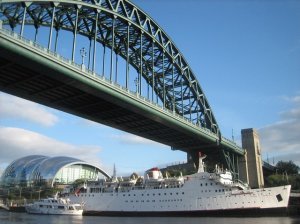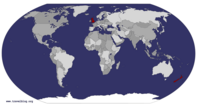Advertisement
Published: December 21st 2007

 The power of steel
The power of steel
The Tyne Bridge, Tyne river traffic and the Sage Gateshead - otherwise known as the Armadillo building.On the approach to Newcastle Upon Tyne, some thirty minutes before our due time, the road suddenly dropped down a steep bank to an absolutely astounding collection of bridges strung across a river. I frantically tried to capture the scene through the grimy bus widows as we crossed, the strong afternoon light fighting me all the way. I craned my neck for one last view to commit to memory as we rose up the other side, not even knowing where we were, and certain I would never see the place again.
Fuming in my seat, I regretted that I hadn’t had the courage to ask the driver to stop - but I could imagine his answer to a passenger wanting a large white coach on a narrow highway crammed with rush hour traffic to make a photo-stop by a bridge…
A huge surprise was in store: only a few minutes later, we pulled up early in the centre of Newcastle - something unprecedented in the three weeks of travel so far. It did not take me long to find the hostel recommended by the motorcycling German I'd met in York, and thrilled with my luck, I trotted straight back

 the Armadillo Building
the Armadillo Building
The Sage Gatehead, a hugely controversial modern Newcastle venue, with some calling it a giant slug and others describing it as iconic modern architecture.down the hill to admire the Gateshead’s magnificent works of engineering.
Some merely metres away from each other, the famous series of bridges are all different shapes, colours and designs - it’s like visiting an engineering theme park. While the low position of the sun was unfortunate for my photographic efforts, I had a good explore along the banks admiring the arches and tunnels above the fast flowing Tyne.
I wrapped up the day attending the evening service in the beautifully painted, Celtic influenced
Cathedral Church of St Mary. The restoration is recent, and I imagine the decorations caused some controversy, as English churches nowadays are normally left as bare stone - this bears more resemblance to the plastered and painted churches of the middle ages.
The next morning I ventured even further back through history. The AD122 bus route (I
know) travels the length of Hadrian’s Wall, from Newcastle in the east to Carlisle in the west. Just days away from switching to the weekend only winter service, it was definitely low season on the bus - there were only two of us leaving the city, and we were able to monopolise the very knowledgeable guide and the driver. They
gave us their opinions on the best sites for a day-tripper to concentrate on, although they earnestly tried to persuade me it would be more fun to stay on the nice warm bus than having a nasty strenuous walk alongside a section of the wall!
They failed to convince me. I wanted to see the Wall close up and follow some of the famous trail, and the section I chose, where the Wall coincides with the edge of Northumberland National Park, is just magnificent. I escaped the bus at the sloping Homesteads fort, one of the largest and most complete ruins along the wall. After looking at the barracks and the very efficiently plumbed latrine block, I walked along the wall towards the village of Once Brewed. Passing several mile castles and forts, the undulating terrain of this section illustrates how well Roman soldiers followed orders: even when encountering a hill or crag, the wall goes straight on up and over, never deviating to easier ground.
Although the weather was atrocious most of the way, I got some excellent views and was excited to see groups who were obviously walking the length of the wall. Judging by the

 Durham Cathedral from the river
Durham Cathedral from the river
The main town centre is a hill, cut off by rivers on three sides, and reached by low bridges. The Cathedral is at the very top - it's easy to see why it appealed to the founders, who lived in terror of more attacks.three miles I followed of the 78 mile trail, it’s a good walk - vigorous at times, but nothing requiring more than an ordinary degrees of fitness and common sense. (And a week to walk it.)
Vindolanda, an ongoing dig which accepts volunteers every summer, was my last stop for the day. They’ve unearthed some unique things there, including hundreds of writing tablets from Roman Britain, giving a sense of the identity of the people who lived here nearly two thousand years ago. I couldn’t spend as much time as I would have liked on the site itself, because the weather packed up and the rain came down. The museum at the bottom of the hill was fascinating though, full of the finds from the dig.
The next day I worked out a complicated itinerary, which involved checking out of my Newcastle hostel, spending the day in Durham, then returning to Newcastle to catch a bus to Berwick Upon Tweed. Unfortunately the bus times were just close enough together for me not to want to risk storing my bag at my Newcastle hostel, just in case the bus was late back from Durham - so I took them

 Gateshead Millenium Bridge
Gateshead Millenium Bridge
Dubbed the "Bridge that Blinks" because it tilts a couple of times a day, to let larger river traffic up the river.with me. This proved to be much more of a struggle than it should have been.
Durham was grim, grey, and filled with annoying people who pushed past me, almost toppling me in my heavily loaded state, as I searched for somewhere to leave my big pack while I climbed to the Cathedral. After a very unsuccessful hunt, I asked for help at the Tourist Office, and was forced to conclude that Durham is gunning for the title of the Unfriendliest City in England. The lady behind the desk told me very flatly that nowhere in town would accept a bag, “because of the security situation.” Nor did she seem to care in the slightest that I was a visitor to the city and might like some help. She offered me no directions and not even one smile.
Thanks, Durham. I feel I should help you with your goal by suggesting a new slogan for your current welcome sign. Perhaps
“You’re not welcome to Durham, the unfriendliest city in Europe.” (If I sound bitter, it’s because I was feeling very hard done by… and yes, I’m bitter about that!) I felt so unwelcome I thought seriously about leaving,

 Millenium Bridge
Millenium Bridge
It was impossible to capture the extreme breadth of the bridge with my little camera, though I had a good go. A wide angle lens is certainly on my wish-list!but sympathy from a couple of friendly Canadians helped, and thinking of all the effort I’d gone to, I climbed the hill anyway, hoping there would be somewhere there to store the bag.
Occasioning many stares as I marched in laden like a packhorse, the lovely Cathedral staff were shocked that I’d had to walk up with all my belongings. They put my bag behind the desk for me, and instantly became my favourite people in the world. I had been planning to wander the town, as well as the Cathedral, but I managed to fill in my time very well wandering the chapels and climbing the tower of the Cathedral, before visiting Durham's two great shrines, the reason for my visit to the city.
The remains of Bede, the Father of English History, are interred in a marble sarcophagus in the Galilee Chapel. The Venerable Bede, a Northumbrian monk born in the seventh century, dedicated himself to recording notable events throughout the his life. He also researched and wrote a five book history of England, religious and political, from Roman times to his present day, (the year 731) which continues to be a hugely important historical work.

 When I was in.... Gateshead
When I was in.... Gateshead
For some reason Goldenhorse just kept running through my head!In a feretory directly behind the High Altar, the shrine of St Cuthbert extends into the Chapel of the Nine Altars. The monks who founded the Cathedral were refugees from the Holy Island of Lindisfarne, which had been pillaged in Viking Raids. Fleeing and wandering for many years with their Saint’s body, they eventually chose Durham’s vantage point, protected on three sides by rivers, as their permanent home. The Cathedral was built as a safe and fit place to house his remains, and pilgrims have come here for centuries.
Fellow schoolmates will no doubt wonder why I sought out the grave of our patron saint. We certainly heard his story often enough in our schooldays - but I felt it was respectful to make a pilgrimage. I lit a candle and sat silently in front of the plain, worn slab, marked simply CVTHBERTVS, and I did not regret the hassle of the journey.
By mid afternoon I was back in Newcastle, in plenty of time for my connection. While I was enjoying the sun in the coach station waiting room, the time for my bus came and went, and eventually the station staff gave us the news:

 Walking the Wall
Walking the Wall
Apparently not just limited to hikers!there was a delay. One of them fetched tea and coffee, and when she saw me and another stranded passenger perusing the offerings in the vending machine, she also fetched us a packet of crisps each - if you're going to be delayed, this is the way to do it. (Yes, I am easily distracted.)
As night fell, the bus arrived, and away we went into the gloom, way up north to the very edge of England…
Advertisement
Tot: 0.331s; Tpl: 0.014s; cc: 15; qc: 64; dbt: 0.2683s; 1; m:domysql w:travelblog (10.17.0.13); sld: 1;
; mem: 1.2mb














